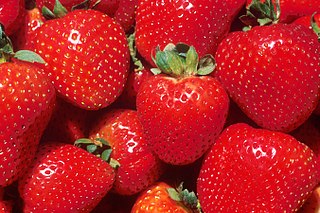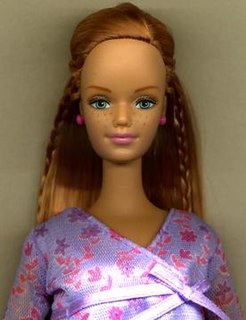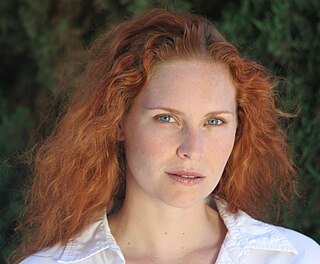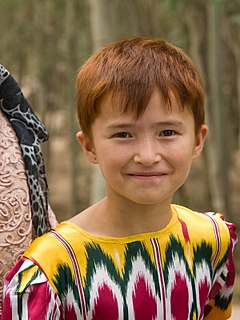
Titian is a tint of red hair, most commonly described as brownish-orange in color. [1] It is often confused with Venetian and auburn.[ citation needed ]

Titian is a tint of red hair, most commonly described as brownish-orange in color. [1] It is often confused with Venetian and auburn.[ citation needed ]
The term originates from Titian, an Italian painter who would often depict women with red hair of this description. Titian has been used as a hair color term in the United States as early as the 1800s, when women were commonly using henna to dye their hair a Titian color.

Titian is commonly misused as a synonym for hair colors with similar definitions or hues of color.[ citation needed ]
Titian hair is frequently mistaken[ citation needed ] with what is called Venetian hair due to similar definitions and origins. Definitions of Venetian hair describe it as being reddish and golden in quality, but the distinction between the two is that Titian is a golden-brown, and Venetian a golden-blond. The two are also often referred to as Titian-red and Venetian-blond, respectively, to emphasize the distinction. [2] [3] The origins of the formulas to create these hair colors by dyeing are also the same. [4] As the Venetian women had more methods to lighten their hair, [4] the term Venetian has become specifically associated with the blond variety.
The term Titian is sometimes misapplied[ citation needed ] to auburn hair. Whereas Titian hair is a brownish shade of red hair, auburn hair is a brownish shade of hair encompassing the actual color red. Most definitions of Titian hair describe it as a brownish-orange color, [5] but some describe it as being reddish. [6] This is in reference to red hair itself, not the color red.
Well, we heard him say—didn’t we, Jane?—‘Who is that girl on the platform with the splendid Titian hair? She has a face I should like to paint.’ There now, Anne. But what does Titian hair mean?” “Being interpreted it means plain red, I guess,” laughed Anne. “Titian was a very famous artist who liked to paint red-haired women.” [7]
— L. M. Montgomery, Anne of Green Gables

Red is the color at the long wavelength end of the visible spectrum of light, next to orange and opposite violet. It has a dominant wavelength of approximately 625–740 nanometres. It is a primary color in the RGB color model and a secondary color in the CMYK color model, and is the complementary color of cyan. Reds range from the brilliant yellow-tinged scarlet and vermillion to bluish-red crimson, and vary in shade from the pale red pink to the dark red burgundy.

Brown can be considered a composite color but is mainly a darker shade of orange. In the CMYK color model used in printing or painting, brown is usually made by combining orange and black. In the RGB color model used to project colors onto television screens and computer monitors, brown is made by combining red and green, in specific proportions.

Midge Hadley is a fictional doll character in the Barbie line of toys by Mattel that was first released in 1963. Midge was created at the same time as Skipper. She was marketed as Barbie's best friend. No Midge dolls were sold for the rest of the vintage years after the 1960s.

Red hair is a hair colour found in one to two percent of the human population, appearing with greater frequency among people of Northern or Northwestern European ancestry and lesser frequency in other populations. It is most common in individuals homozygous for a recessive allele on chromosome 16 that produces an altered version of the MC1R protein.

Hair color is the pigmentation of hair follicles due to two types of melanin: eumelanin and pheomelanin. Generally, if more melanin is present, the color of the hair is darker; if less melanin is present, the hair is lighter. The tone of the hair is dependent on the ratio of black or brown eumelanin to yellow or red pheomelanin. Levels of melanin can vary over time causing a person's hair color to change, and it is possible to have hair follicles of more than one color on the same person. Some hair colors are associated with some ethnic groups due to observed higher frequency of particular hair color within their geographical region, e.g. straight dark hair amongst East Asians, a large variety of dark, fair, curly, wavy and bushy hair amongst Europeans, curly, dark, and uniquely helical hair with Africans, whilst gray, white or "silver" hair is often associated with age and wisdom.

Blond or fair hair, also blonde, is a hair color characterized by low levels of the dark pigment eumelanin. The resultant visible hue depends on various factors, but always has some yellowish color. The color can be from the very pale blond to reddish "strawberry" blond or golden-brownish ("sandy") blond colors. Occasionally, the state of being blond, and specifically the occurrence of blond traits in a predominantly dark or colored population are referred to as blondism.

Brown hair is the second most common human hair color, after black hair. It varies from light brown to a medium dark hair. It is characterized by higher levels of the dark pigment eumelanin and lower levels of the pale pigment pheomelanin.

Sorrel is a reddish coat color in a horse lacking any black. It is a term that is usually synonymous with chestnut and one of the most common coat colors in horses. Some regions and breed registries distinguish it from chestnut, defining sorrel as a light, coppery shade, and chestnut as a browner shade. However, in terms of equine coat color genetics there is no known difference between sorrel and chestnut. Solid reddish-brown color is a base color of horses, caused by the recessive e gene.

Bay is a hair coat color of horses, characterized by a reddish-brown or brown body color with a black point coloration of the mane, tail, ear edges, and lower legs. Bay is one of the most common coat colors in many horse breeds.

Skipper Roberts is a doll created by Mattel in 1964 to be Barbie's younger sister.
Bimbo is slang for a conventionally attractive, sexualized, naive, and unintelligent woman. The term was originally used in the United States as early as 1919 for an unintelligent or brutish man.
Maroon is a brownish crimson color that takes its name from the French word marron, or chestnut. "Marron" is also one of the French translations for "brown".

Auburn hair is a human hair color, a variety of red hair, most commonly described as reddish-brown in color or dark ginger. Auburn hair ranges in shades from medium to dark. It can be found with a wide array of skin tones and eye colors. The chemical pigments that cause the coloration of auburn hair are frequently pheomelanin with high levels of eumelanin; however, the auburn hair is due to a mutated melanocortin 1 receptor gene in Northwestern European people and by a mutated TYRP1 gene in the Melanesians and Austronesians, both genes that reduce the melanin production of the hair cells.

The blue hour is the period of twilight when the Sun is at a significant depth below the horizon. During this time, the remaining sunlight takes on a mostly blue shade. This shade differs from the colour of the sky on a clear day, which is caused by Rayleigh scattering.

Chestnut is a hair coat color of horses consisting of a reddish-to-brown coat with a mane and tail the same or lighter in color than the coat. Chestnut is characterized by the absolute absence of true black hairs. It is one of the most common horse coat colors, seen in almost every breed of horse.

Horses exhibit a diverse array of coat colors and distinctive markings. A specialized vocabulary has evolved to describe them.

The French hood is a type of woman's headgear that was popular in Western Europe in the 16th century.
In optics, orange has a wavelength between approximately 585 and 620 nm and a hue of 30° in HSV color space. In the RGB color space it is a secondary color numerically halfway between gamma-compressed red and yellow, as can be seen in the RGB color wheel. The complementary color of orange is azure. Orange pigments are largely in the ochre or cadmium families, and absorb mostly blue light.

Bole is a shade of reddish brown. The color term derives from Latin bōlus and refers to a kind of soft fine clay whose reddish-brown varieties are used as pigments, and as a coating in panel paintings and frames underneath the paint or gold leaf. Under gold leaf, it "warms" the colour, which can have a greenish shade otherwise. However, bole in art is a good deal more red and less brown than the modern shade; it is often called Armenian bole. Although bole also means the trunk of a tree, these words are simply homographs that do not share an etymological origin.
The Barbie Basics is a line of collector's edition Barbie dolls. They were created by Mattel designer Bill Greening and were introduced in late 2009 to be officially released in the spring of 2010.
titian.